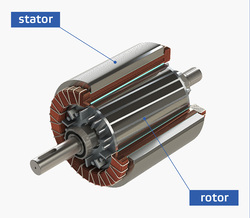Three-phase motor controls - 230 VAC
This group includes a series of manual five-step basic transformer fan speed controllers for three-phase AC motors, 230 VAC.
What is 3-phase AC motor?
An alternating current (AC) motor is an electric device designed to transform electrical energy derived from alternating current (AC) into mechanical energy. Typically, it comprises a rotor, the component responsible for rotation, and a stator, which remains stationary. When linked to a source of alternating current, the stator produces a magnetic field that induces rotation in the rotor. This rotation results from the interaction between the rotating magnetic field generated by the stator and the rotor of the motor.

A 3-phase motor works by harnessing three alternating currents to produce a rotating magnetic field, which, in turn, drives the rotor and induces rotation. This design enhances efficiency and performance, making 3-phase motors suitable for a wide range of industrial applications.
AC motors have been the dominant motor type in industrial applications and in the HVAC industry. Because of the wide range of variable speed drives and increasingly intelligent control solutions, the possible applications seem endless. AC motors are extremely reliable and very robust. They hardly ever require maintenance and if they break down, they are easy to repair. AC motors are the industry standard and are therefore widely available in a very wide power range.
AC voltage controllable motors
Voltage controllable motors are asynchronous motors whose speed can be controlled by reducing the voltage. When the nominal voltage is applied, the motor runs at high speed. When the motor voltage is reduced, the motor will slow down accordingly.
When the motor voltage decreases, the maximum motor torque also decreases. As long as the motor remains powerful enough to drive the load, the motor speed can be controlled by reducing the voltage. Note that not all motors are voltage controllable.
AC motors have been the dominant motor type in industrial applications and in the HVAC industry. Because of the wide range of variable speed drives and increasingly intelligent control solutions, the possible applications seem endless. AC motors are extremely reliable and very robust. They hardly ever require maintenance and if they break down, they are easy to repair. AC motors are the industry standard and are therefore widely available in a very wide power range.
AC voltage controllable motors
Voltage controllable motors are asynchronous motors whose speed can be controlled by reducing the voltage. When the nominal voltage is applied, the motor runs at high speed. When the motor voltage is reduced, the motor will slow down accordingly.
When the motor voltage decreases, the maximum motor torque also decreases. As long as the motor remains powerful enough to drive the load, the motor speed can be controlled by reducing the voltage. Note that not all motors are voltage controllable.
230 VAC three-phase transformer-based motor controllers
The three-phase transformer-based controllers regulate fan speed by altering the supply voltage in five fixed steps. The steps are adjusted manually, using the control knob on the front of the unit.
The autotransformers integrated into the controllers adjust the motor voltage, thereby altering its speed. Here, two transformers are combined using a special technique to do three phase transformations. This process is highly effective, leading to a substantial reduction in power consumption, up to 95%, and operates noiselessly. When employed to regulate multiple fans, it is essential to ensure that the combined full-load amps of all connected fans do not surpass 85% of the controller maximum rating. Additionally, it is crucial for the fans to be identical, and the motors must be specifically designed to facilitate speed control through voltage reduction.
The autotransformers integrated into the controllers adjust the motor voltage, thereby altering its speed. Here, two transformers are combined using a special technique to do three phase transformations. This process is highly effective, leading to a substantial reduction in power consumption, up to 95%, and operates noiselessly. When employed to regulate multiple fans, it is essential to ensure that the combined full-load amps of all connected fans do not surpass 85% of the controller maximum rating. Additionally, it is crucial for the fans to be identical, and the motors must be specifically designed to facilitate speed control through voltage reduction.
